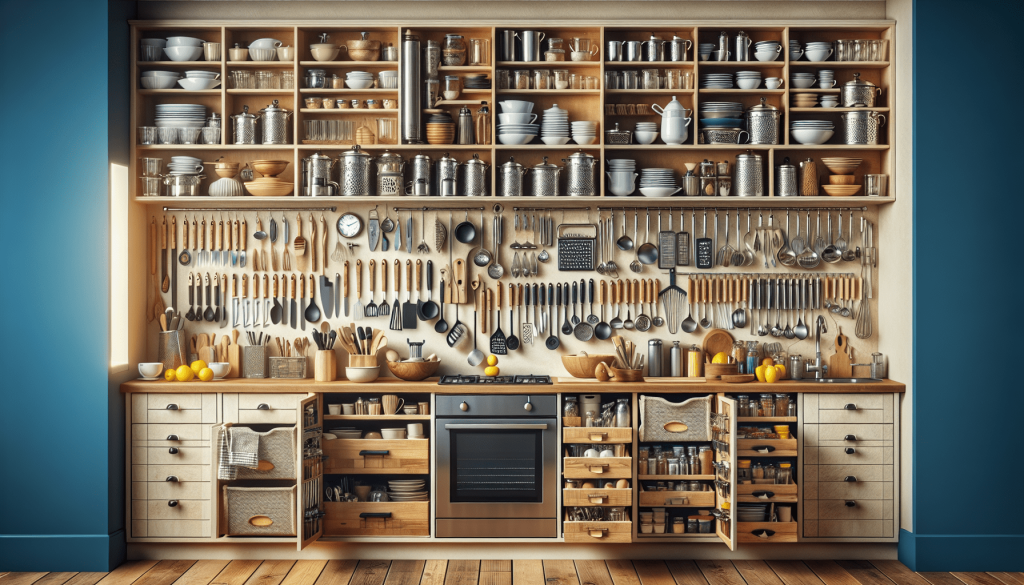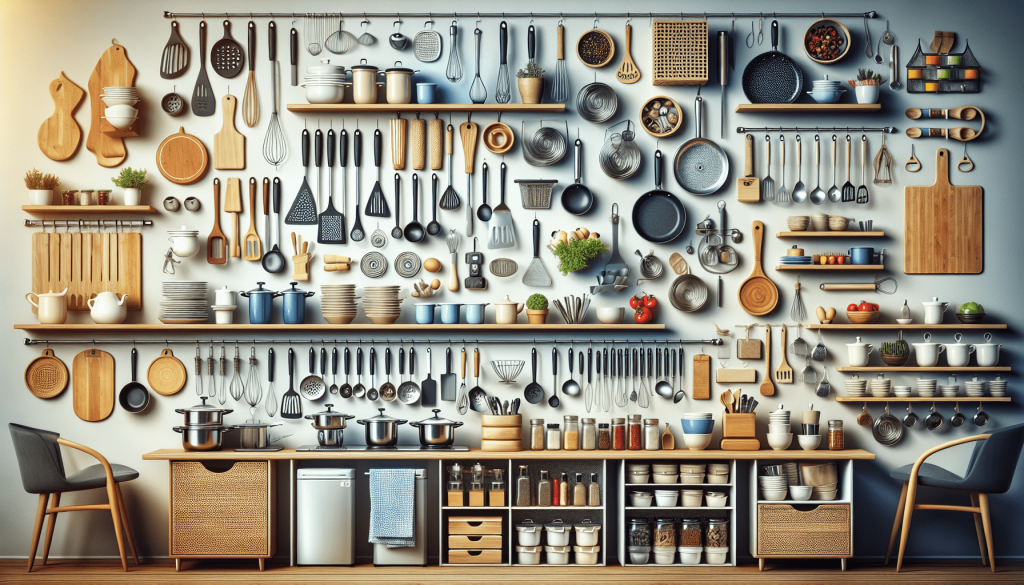Keeping your kitchen utensils in order is essential for maintaining a functional and efficient cooking space. No one wants to spend precious minutes searching for that elusive spatula or whisk in the midst of preparing a meal. With these helpful tips, you’ll be able to organize your kitchen utensils in a way that maximizes convenience and minimizes clutter. Say goodbye to the frustration of a messy kitchen drawer and hello to a streamlined and well-organized culinary experience.
Declutter and Sort
Remove unused utensils
Start by going through your kitchen utensils and removing any items that you rarely or never use. This will help you declutter your kitchen and create more space for the items you actually need. Ask yourself if you’ve used each utensil in the past year, and if the answer is no, it’s time to say goodbye.
Group similar utensils together
Once you’ve eliminated the unused utensils, it’s time to group similar items together. This will make it easier to find what you need when cooking and prevent clutter. For example, you can group all your spatulas, tongs, and whisks together, and keep all your measuring cups and spoons in one place.
Sort utensils by frequency of use
When organizing your utensils, it’s helpful to sort them based on how often you use them. Place the frequently used items within easy reach, such as in a utensil crock on the countertop. Less frequently used utensils can be stored in cabinets or drawers. By sorting your utensils this way, you can save time and make your cooking experience more efficient.
Create Zones
Designate specific areas for different utensils
To further enhance the organization of your kitchen utensils, consider designating specific areas for different types of utensils. For example, you can have a baking zone where you store all your baking utensils, such as measuring spoons, rolling pins, and pastry brushes. This way, you’ll always know exactly where to find the utensils you need for specific tasks.
Arrange utensils based on functionality
Within each designated zone, arrange your utensils based on their functionality. Place the items you use most frequently at the front for easy access. For example, if you bake often, keep your measuring spoons and cups at the front, followed by your mixing bowls and spatulas. This way, you can quickly grab the utensils you need without having to search through a jumble of items.

Use Drawer Dividers
Separate utensils using dividers
Drawer dividers are a game-changer when it comes to organizing your kitchen utensils. They allow you to separate and categorize your utensils, making it easier to find what you need. Use dividers to create separate sections for different types of utensils, such as one section for knives, one for serving spoons, and another for gadgets.
Customize dividers for different utensils
Customizing your dividers can make a big difference in the efficiency of your kitchen organization. Consider using adjustable dividers that can be resized to accommodate different utensil sizes. This will allow you to create the perfect fit for each utensil, preventing them from sliding around and getting mixed up.
Hang Utensils
Install hooks or racks for hanging utensils
Hanging utensils can save valuable drawer and countertop space while also adding a decorative touch to your kitchen. Install hooks or racks on your walls or the inside of cabinet doors to hang your utensils. This way, they will be easily accessible and visible, making it a breeze to find the utensil you need.
Utilize wall space for easy access
Make the most of your kitchen’s wall space by hanging your utensils. This is especially useful for frequently used items like spatulas, ladles, and whisks. Consider installing a pegboard or a wall-mounted rack with hooks. It not only keeps your utensils organized but also adds a touch of charm to your kitchen decor.

Invest in Storage Solutions
Use drawer inserts for small utensils
For small utensils like measuring spoons, peelers, and can openers, drawer inserts are invaluable. These small compartments will keep these items neatly organized and prevent them from getting lost in a sea of larger utensils. Consider using expandable drawer inserts that can adjust to fit different drawer sizes.
Install magnetic strips for metal utensils
Magnetic strips are a fantastic storage solution for metal utensils such as knives and metal serving spoons. Mount a magnetic strip on a wall or the inside of a cabinet door, and your metal utensils will be securely held in place. This not only frees up drawer space but also keeps your knives easily accessible and safely stored.
Utilize Cabinet Space
Adjust shelves to accommodate taller utensils
If you have tall utensils like ladles or soup spoons, make sure to adjust your cabinet shelves accordingly. By rearranging the shelves, you can create enough vertical space to accommodate these taller utensils without wasting any valuable storage space. This will keep your utensils organized and prevent them from getting damaged.
Use stackable containers for organizing
Stackable containers are a great way to make the most of your cabinet space and keep your utensils organized. Use them to store items like measuring cups, silicone spatulas, and food scoops. Stackable containers not only help maximize vertical space but also make it easier to see and access the utensil you need.
Label Containers
Label containers for easy identification
Labeling your containers is a simple yet effective way to keep your kitchen utensils organized. Use adhesive labels or a label maker to clearly mark the contents of each container. This helps you quickly find the utensil you need, especially when you have multiple containers with similar-looking items.
Use clear containers for visibility
Opt for clear containers when organizing your kitchen utensils. Clear containers allow you to see the contents at a glance, eliminating the need to open each container to find what you’re looking for. This not only saves time but also ensures that everything stays organized and easily accessible.
Store Knives Safely
Use knife blocks or holders
When it comes to storing knives, safety is paramount. Avoid keeping them loosely in a drawer, as this can lead to accidents and damage to both the knives and your hands. Invest in a quality knife block or holder that securely stores and protects your knives, while also keeping them easily accessible for your cooking needs.
Consider knife covers or sheaths
If you often need to transport or store your knives, consider using knife covers or sheaths. These protective covers help prevent accidents and keep the blades in top condition. Knife covers also allow you to store your knives in drawers without the risk of accidentally cutting yourself when reaching in.
Keep Frequently Used Utensils Handy
Store often used utensils on the countertop
For the utensils you use on a daily basis, it’s convenient to have them within easy reach. Consider using a utensil crock or a decorative jar on your countertop to store your frequently used items, such as spatulas, wooden spoons, and whisks. This keeps them handy during food preparation and cooking, saving you time and effort.
Use a utensil crock for easy access
A utensil crock is a practical and stylish way to keep your frequently used utensils organized. Place it near your stove or food preparation area for easy access. A utensil crock not only keeps your utensils within arm’s reach but also adds a touch of charm to your kitchen decor.
Regularly Clean and Maintain
Clean utensils regularly
Regular cleaning and maintenance are essential for keeping your kitchen utensils in tip-top condition. Wash your utensils after each use to remove any food residue and prevent the buildup of bacteria. Use hot, soapy water and a scrub brush to thoroughly clean each utensil, then dry them completely before storing.
Inspect and replace damaged utensils
Periodically inspect your kitchen utensils for signs of wear and tear. Replace any utensils that are damaged or no longer function properly to prevent accidents and ensure your cooking experience is safe and efficient. By regularly assessing the condition of your utensils, you can maintain an organized and functional kitchen.
